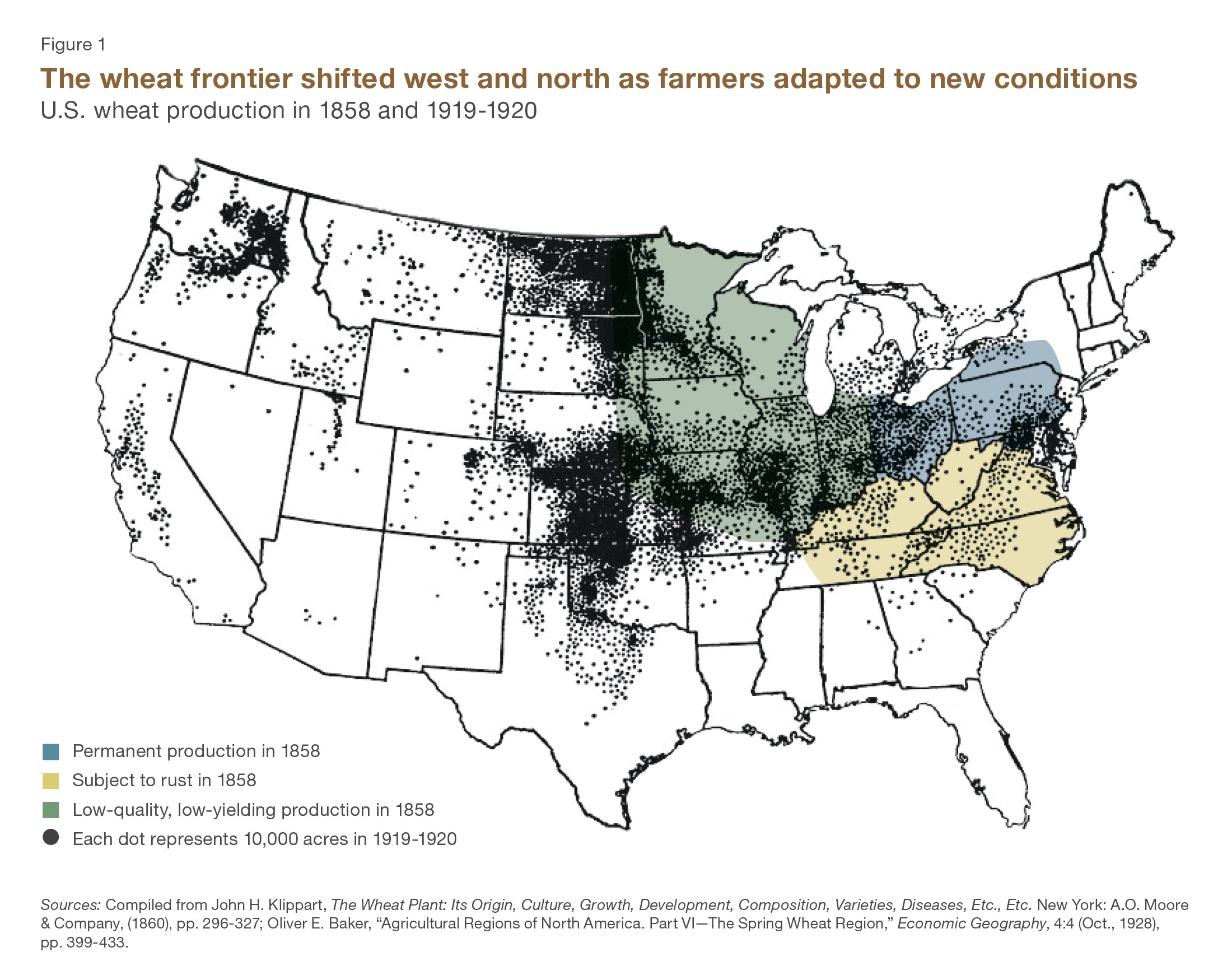Wheat is taking a wallop. In recent years, weather shocks in many of the world’s major wheat-growing regions have sapped yields and output. In Australia, for example, severe drought has plagued much of the country since 2003, with only limited spells of relief, and its grain crops have suffered. During the Great Russian Heat Wave of 2010, summer temperatures exceeded any observed in 130 years of recordkeeping, ravaging wheat crops and leading to a ban on grain exports. In the winter of 2010-11, a drought across the North China Plains—purportedly the worst in two centuries—endangered China’s winter wheat crop. And in a globalized economy, local crises such as these—or even prospective crises—can have immediate effects worldwide. Adverse shocks to grain supplies raise global prices, threatening the food security of developing countries and potentially fueling political unrest.
The recent succession of weather-related harvest shocks has heightened concerns that global climate change is making it harder to feed the world, a recurrent theme in the mainstream press and leading academic journals. In a 2011 article in Science, Stanford scientist David B. Lobell and co-authors reported that between 1980 and 2008, global warming reduced wheat yields in major producing countries by 5.5 percent compared to what would have been the case without the warming trends. A spate of more recent studies suggests a 6 percent fall in wheat yields for every 1 degree Celsius (C) increase in temperature, all else equal. One prominent study by researchers at the International Maize and Wheat Improvement Center anticipates that North American wheat farmers will have to cease production at the southern end of the grain belt by the year 2050.
These recent travails are new in that agriculturalists have never faced such a rapid widespread increase in temperature and the expected accompanying increases in weather variability; however, a more general form of the problem—overcoming environmental challenges—is nothing new. Wheat is no stranger to threatening environmental conditions, and farmers have a centuries-long track record of overcoming harsh growing conditions and climate challenges. Between 1839 and 2008, wheat output in the United States increased 26-fold, and in Canada it increased 270-fold. These increases in output depended in part on pushing wheat production into new environments. The historical record of this migration in production helps inform how agricultural producers adapt to climatic changes—and it just may shed light on the challenges farmers will face to grow enough grain to feed future populations.
To help understand the prospects for adapting to predicted climate change, it’s useful to examine how farmers who settled the North American continent adapted wheat production to new areas, particularly locations with significantly harsher and more variable environments. These changes, for the most part, occurred before the advent of modern plant genetics. This historical adjustment process indicates the malleability of the agricultural enterprise: something that many past experts failed to appreciate when they made doomsday predictions about the future.
‘An Unproductive Desert’
In the mid-19th century, John Klippart was arguably the most-informed person in North America on wheat. As a member of the Ohio State Board of Agriculture, Klippart published a 700-page tome in 1858 that detailed much of what was then known about wheat farming around the world. In Klippart’s view, agro-climatic conditions limited the permanent commercial wheat belt to the area between the 33rd and 43rd latitudes, which encompasses Ohio, the southern parts of Michigan and New York, Pennsylvania, Maryland, Delaware, and Virginia. The soils in the latter three states had been largely exhausted, and without considerable investment in fertilizer, he predicted that production would soon decline.
Although there had been a large increase in wheat output west of Ohio, Klippart maintained that the soils and climates of Illinois, Iowa, and Wisconsin would ultimately doom those states to haphazard production of low-quality and low-yielding spring wheat. Farther west, the area that would later become North America’s great wheat belt was mostly “an unproductive desert.” And in the South, rust infestations (a class of fungal infections that can devastate wheat crops) were expected to forever limit production. Unless the country husbanded its resources, Klippart surmised, it would soon become an importer of wheat. In addition, he argued that “Canada may be left out of the wheat region” due to declining productivity.
Reality swamped Klippart’s calamitous predictions (see Figure 1). By 1919-20, wheat production covered an area much vaster than Klippart could ever have imagined. His estimates proved so far off the mark because he failed to anticipate the biological innovations that would transform North American wheat production. And as impressive as the geographic spread of wheat production was, the accompanying shifts in the ranges of growing conditions were even more amazing. According to Mark Alfred Carleton, a prominent agronomist with the U.S. Department of Agriculture, the regions of North America producing wheat in the early-20th century were as “different from each other as though they lay in different continents.”

These shifts reflect dramatic changes in the distribution of production across climatic conditions. In 1839, the year data became available, a typical wheat farm had nearly 100 cm of annual precipitation. In 2007, the typical wheat farm received less than 50 cm of precipitation per year—a drier environment than virtually any place that had grown wheat in the United States or Canada in 1839. As the growing gap between the 5 and 95 percent lines in Figure 2 indicates, the range of precipitation conditions widened significantly. The driest 5 percent of wheat production received about 80 cm of precipitation in 1839 but only about 35 cm in 1907. And because of the overall increase in production, more wheat was grown with 35 cm of precipitation in 2008 than was grown in all of North America in 1839.
The range of temperature conditions also widened greatly. The most pronounced movement of wheat production was into colder domains. Between 1839 and 2007, the area of cultivation shifted so much that median annual temperature norms for wheat-producing areas fell by 3.7 degrees C. Furthermore, the coldest 10 percent of production as measured by January temperature occurred where the norm was -5.1 degrees C in 1839 but -17.7 degrees C in 1929, a fall of 12.6 degrees.
Wheat’s expansion was not limited to places with colder climates—the crop spread to hotter areas as well. In 1839, 5 million bushels of wheat were produced in areas with a July temperature norm of 26 degrees C or hotter. By 1929, more than 192 million bushels were produced under such conditions.
How Wheat Farmers Adapted
Agricultural production is location specific, at the mercy of conditions that differ across regions and even across neighboring farms. Settlement was intrinsically a biological process that required wheat farmers to harmonize their production practices with specific local soil and climatic conditions. New lands often required new varieties and agricultural techniques for wheat growing to thrive. It was common for the initial settlers of a region to fail, because it often took years or even decades to discover varieties and production techniques appropriate to the strange environments. Success often involved selecting an area that had an environment similar to that “back home.”
The Mennonites, who moved from the Russian steppes to the Great Plains of North America in the late-19th century, offer an example. Among their cargo was Turkey wheat, a hard red winter wheat that became a mainstay in the southern U.S. wheat belt. Success for those farmers already in place often involved searching for suitable seed from around the world. Sometimes this occurred through happenstance, as in the case of the 1842 discovery by David and Jane Fife of a hardy red spring wheat amongst a packet of winter wheat seed sent from Scotland. This wheat, eventually named after Fife, made possible the expansion of grain cultivation across the northern plains and Canadian prairies.
Increasingly, the search for suitable seeds took on a systematic global nature. At the turn of the 20th century, USDA wheat specialist Mark Alfred Carleton scoured the Russian Empire seeking wheats that thrived in harsh environments. He introduced scores of new varieties, including durum wheats, to the Great Plains.

In Australia, government researchers made innovations that were more akin to those needed to confront global warming—the most important of which was William Farrer’s breeding of the Federation variety of wheat, which helped extend the crop into hot and arid regions previously too hostile for cultivation. There are similar stories of government-supported researchers helping expand wheat’s geographical domain in South America, Africa, Europe, and Asia.
The Perils of Crop Predictions
Since the time of Malthus, there have been dire predictions about the future of the world’s food supplies. The repeated failures of such projections have led many observers to dismiss the entire “pessimistic” enterprise out-of-hand. But it is important to recall the example of Sir William Crookes, whose prophecies of mass starvation in his presidential address to the British Association for the Advancement of Science received wide currency in the closing years of the 19th century. Crookes worried that the settlement and globalization process discussed above was coming to an end, that the world was running out of new wheat lands, and that the food supply would soon fail to keep pace with population.
Crookes’ predictions, though ultimately proved wrong, had consequences. He argued there was a way out: Learn to fix atmospheric nitrogen to create fertilizers and raise yields on existing soils. Crookes’ powerful statement of the problem and his proposed solution helped prompt the chemist Fritz Haber to initiate a search for such a new technology. Haber began experimenting with ammonia in 1904, and after a hit-and-miss start, he gained the support of the German chemical giant Badische Anilin- & Sodafabrik (BASF) in 1908.
Current concerns about the impact of global climate change on wheat production and agriculture more generally are real. Adaptation will be one important key to addressing the problem, just as it has been for centuries.
In 1909, Haber sent a letter to the BASF directors describing his recent breakthrough in synthesizing ammonia. Led by Carl Bosch, who headed BASF’s nitrogen fixation research, the company overcame numerous technical obstacles to translate Haber’s experimental procedures into a large-scale commercial operation. BASF’s first ammonia fertilizer plant went on line in 1913. Subsequent improvements in the production process dramatically increased the supply of nitrogen while lowering its price. Scientist and author Vaclav Smil has elevated Fritz Haber and Carl Bosch’s nitrogen synthesis processes to high prominence, claiming that “without this synthesis about 2/5 of the world’s population would not be around.” With Bosch’s aid, Haber rendered Crookes’ prophecies wrong not by adopting a dismissively optimistic attitude, but rather by taking Crookes’ challenges seriously and searching for a creative response.
Current concerns about the impact of global climate change on wheat production and agriculture more generally are real; if the now widely accepted predictions on climate trends are correct, we are amidst rapid changes unprecedented in the human era. The progressive actions of farmers, researchers, government agencies, and private industry proved able to surmount many previous climate challenges because agriculturalists were able to adapt in unforeseen ways not only to maintain the supply of wheat but also to vastly increase it. The alarms of the past stimulated research—including farmer experimentation—that proved up to most challenges. There is no doubt that as the effects of climate change continue to manifest themselves, adaptation will be one important key to addressing the problem, just as it has been for centuries.





